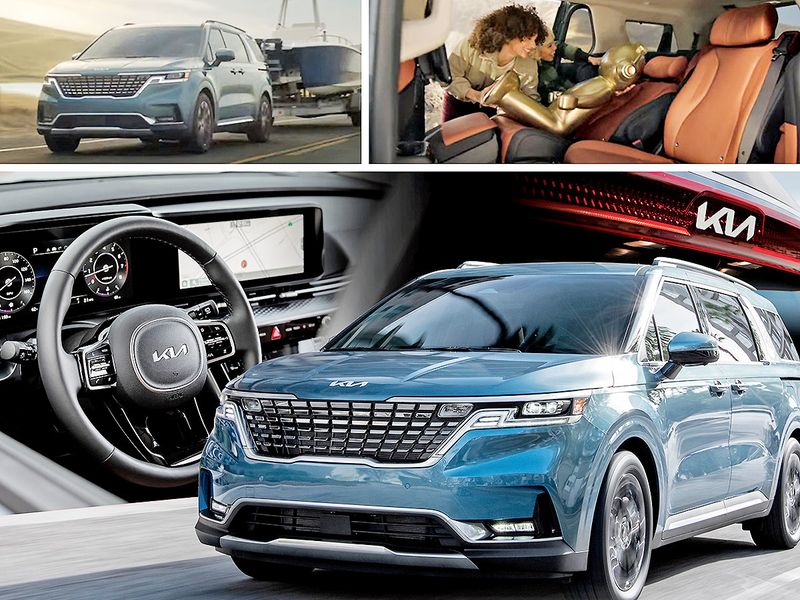
Kia’s ad push for the Carnival MPV has a flair normally seen in spots for versatile utility vehicles.
The stylish people hauler breezes down a desert road pulling a boat, showcasing its towing chops as well as blind-spot monitoring and lounge-style seating that reclines. Throughout the ad, a series of life moments such as camping and dirt-bike riding play out as the Carnival passes by.
Despite the prominent sliding door on each side, the M-word is never uttered. Kia says the minivan label doesn’t quite fit the Carnival, which replaces the Sedona in its North American lineup this year, and it says some consumers agree. So it’s using the term MPV, which stands for multipurpose vehicle — and even treating it as part of the vehicle’s name.
“Most of our customers, when we did clinics, they looked at it and they didn’t see it as a minivan,” Russell Wager, vice president of marketing for Kia Motors America, told Automotive News. “That’s actually where we got the idea that [the Carnival] has an opportunity for greater appeal. It has greater capability. A minivan doesn’t fully describe what this thing can do. It has the utility, the flexibility, [and] the design has a little bit of that SUV attitude. That’s kind of what we wanted to demonstrate in our communications to the customers.”
The Carnival has the goods to help it play in the minivan space, but the automaker doesn’t want to link the vehicle with a segment that has been declining for more than a decade.
Kia is thinking broader, with an eye on snagging sedan owners who are ready for a crossover — only to find themselves intrigued by the Carnival and its SUV-like proportions.
The Carnival, which began hitting dealerships in March, could even attract some unexpected eyeballs.
Wager said one customer walked inTP a Kia store in Phoenix looking for the popular Telluride, the brand’s fast-selling eight-seater, but saw the Carnival and opted for that instead.
Matt Degen, editor of Kelley Blue Book and Autotrader, said Kia was wise to give the Carnival a Telluride-like design. Technically, though, it’s still a minivan, Degen said.
“No matter what you call this, if you are a family who needs seating for seven or eight and you want that ease of access and that flexibility, you’re going to find this vehicle one way or the other,” Degen said. “I think it’s great that they’re doing this because the world is shifting toward SUVs. People want those more ruggedized looks, or those blockier looks.”
Wager said the Carnival is building on what Kia started with the Telluride, Seltos and Sorento crossovers.
“It’s not that we’re afraid of ‘minivan,’ ” he said. “When we did the clinic, the customers are saying, ‘Well, the exterior is in line with your Telluride and Sorento, so it’s just another derivative of your capable SUVs that you have out there.’ We’re not trying to avoid it; the customers have told us that that’s not what the vehicle is.”
Kia isn’t the first automaker that has attempted to drop the minivan label on a capable family hauler or to adopt the term MPV, which is commonly used in other parts of the world. Mazda sold a minivan that was actually called the MPV; it was fortified with all-wheel drive, which Degen said gave it the credentials of a utility vehicle.
The Carnival comes only in front-wheel drive, ceding ground to the Toyota Sienna and Chrysler Pacifica. Those two minivans also offer electrification — all Siennas are now hybrids, and there’s a plug-in hybrid Pacifica — while the Carnival doesn’t.
Those differences highlight one of the challenges Kia faced when devising a marketing strategy for the Carnival: The minivan segment is losing market share, but the remaining competitors aren’t “resting on their laurels,” Wager said.
Tyson Jominy, vice president of data and analytics at J.D. Power, said the minivan segment is tough to crack. Pitting the Carnival head-to-head with the Sienna, Pacifica and Honda Odyssey as a pure minivan trying to differentiate itself, Jominy said, would’ve been a formidable task.
Indeed, the Sedona ranked fifth out of six minivans in the U.S. last year, accounting for less than 5 percent of the segment’s volume. So Jominy sees value in Kia changing lanes to promote the Carnival as an MPV instead.
“I really liked the approach of sort of the end around, filling that niche in between minivan and SUV and seeing what’s there,” Jominy said. “I would argue that the outgoing Sedona already kind of attempted that with the cockpit design, but I think this takes it one step further with the external design.”
Another obstacle, Wager said, was figuring out whom Kia would talk to about a nameplate that’s new to U.S. consumers. (The automaker already used the Carnival name outside North America.)
Kia has since settled on the active-lifestyle message and will push it during NBA programming — the automaker is a league sponsor — in addition to hyping it on digital platforms and in print. Kia also sponsors several NBA teams, so fans returning to arenas might see some Carnival displays, too, Wager said.
The lively ad campaign could be coming at an ideal time now that many Americans are getting COVID-19 vaccinations and are ready to get out more.
“Six months ago I would have said, ‘Oh, my God, we’ve got a brick wall obstacle coming at us,’ ” Wager said. “Now it’s starting to open up, people are wanting to go places. They want to go on the road trips, they want to go visit the friends and family, they want to go camping, they want to do all the things that we haven’t been able to do. So we’re talking to them, I think, at the exact right time about this vehicle.”